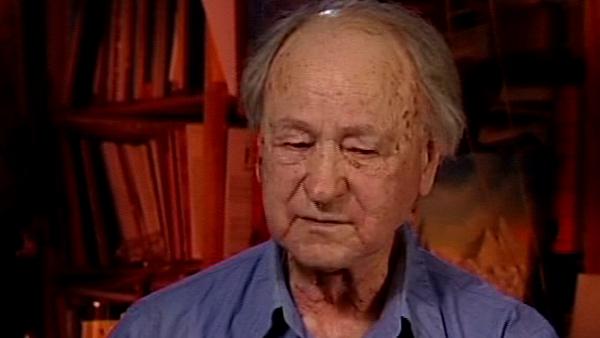NEXT STORY

Story-telling and writing poetry takes me back to my 5-year-old self
RELATED STORIES

NEXT STORY

Story-telling and writing poetry takes me back to my 5-year-old self
RELATED STORIES


|
Views | Duration | |
|---|---|---|---|
| 1. The beginning: birthdays were not important | 2529 | 01:55 | |
| 2. Growing up close to Nature | 2 | 664 | 02:01 |
| 3. A prodigy in the making | 359 | 01:24 | |
| 4. Keeping a diary from the age of four | 433 | 02:03 | |
| 5. Early experiences of film | 465 | 03:02 | |
| 6. Story-telling and writing poetry takes me back to my 5-year-old... | 274 | 02:01 | |
| 7. Singing folk songs was a way of life | 328 | 02:16 | |
| 8. Learning languages | 446 | 02:30 | |
| 9. Learning the 'wrong' kind of cinema | 310 | 01:16 | |
| 10. Getting top grades at school | 219 | 01:47 |

The teacher took us to the next... to the city, which of course was just a town, and that's where I saw some kind of melodrama that I don't remember, but I remember a Disney cartoon very well and that was the first introduction to cinema.
Later, when the Soviets came in 1940, they erected tents in the villages and they showed propaganda movies and also films like Chapayev and that was already in 1940, so my entrance into cinema was very, very late. And, of course, even when I was already after the war in Germany in the displaced persons camps, during the war, I mean, the forced labour camp in... near Hamburg, I saw a lot of German, you know, German, usual commercial cinema and then after the war, I saw mostly what was sent to the army. Sort of a lot of Westerns and comedies, and there was nothing of great interest. So, only when I began studying at the University of Mainz and that was in '47, and that means I was already 23 or something, when I saw the first films of any, of some importance, like I saw, Beauty and the Beast and the post-war, the post-war French cinema. And that's where we, and also, the post-war German cinema, which was quite exciting, not perfect, nothing great was produced, but the... backgrounds were the post-war Germany, there were very new, you know, really, new realistic and that was that imagery of reality in the background, the place like Helmut Kautner people like that, Staudte, was very, very refreshing and very, very exciting to see the real, or the post-war reality there on the screen. That's where myself and Adolfas, my brother, we began thinking that, hah, there is something here.
Jonas Mekas (1922-2019), Lithuanian-born poet, philosopher and film-maker, set up film collectives, the Anthology Film Archive, published filmzines and made hundreds of films, all contributing to his title as 'the godfather of American avant-garde cinema'. He emigrated to America after escaping from a forced labour camp in Germany in 1945.
Title: Early experiences of film
Listeners: Amy Taubin
Amy Taubin is a contributing editor for "Film Comment" magazine and "Sight and Sound" magazine. Her book, "Taxi Driver", was published in 2000 in the British Film Institute's Film Classics series. Her chapter on "America: The Modern Era" is part of "The Critics Choice" published by Billboard Press, 2001, and her critical essays are included in many anthologies, mostly recently in "Frank Films: The Film and Video Work of Robert Frank" published by Scalo.
She wrote for "The Village Voice" weekly from 1987 into 2001 both as a film and a television critic. She also wrote a column for the "Village Voice" titled "Art and Industry" which covered American independent filmmaking. Her first weekly film criticism job was at the "SoHo Weekly News". Her writing has also appeared in "Art Forum", the "New York Times", the "New York Daily News", the "LA Weekly", "Millennium Film Journal", "US Harpers Bazaar" and many other magazines. She is a member of the National Society of Film Critics and the New York Film Critics Online.
She started her professional life as an actress, appearing most notably on Broadway in "The Prime of Miss Jean Brodie", and in avant-garde films, among them Michael Snow's "Wavelength", Andy Warhol's "Couch", and Jonas Mekas' "Diaries, Notebooks and Sketches".
Her own avant-garde film, "In the Bag" (1981) is in the collection of the Museum of Modern Art and the Friends of Young Cinema Archives in Berlin.
She was the video and film curator of "The Kitchen" from 1983-1987.
She has a B.A. from Sarah Lawrence College and an M.A. from N.Y.U. in cinema studies. She teaches at the School of Visual Arts in both the undergraduate and the MFA graduate programs, and lectures frequently at museums, media centers, and academic institutions. In 2003, she received the School of Visual Arts' art historian teaching award.
Tags: University of Mainz, Chapayev, Beauty and the Beast, Helmut Kautner, Wolfgang Staudte
Duration: 3 minutes, 3 seconds
Date story recorded: September 2003
Date story went live: 24 January 2008